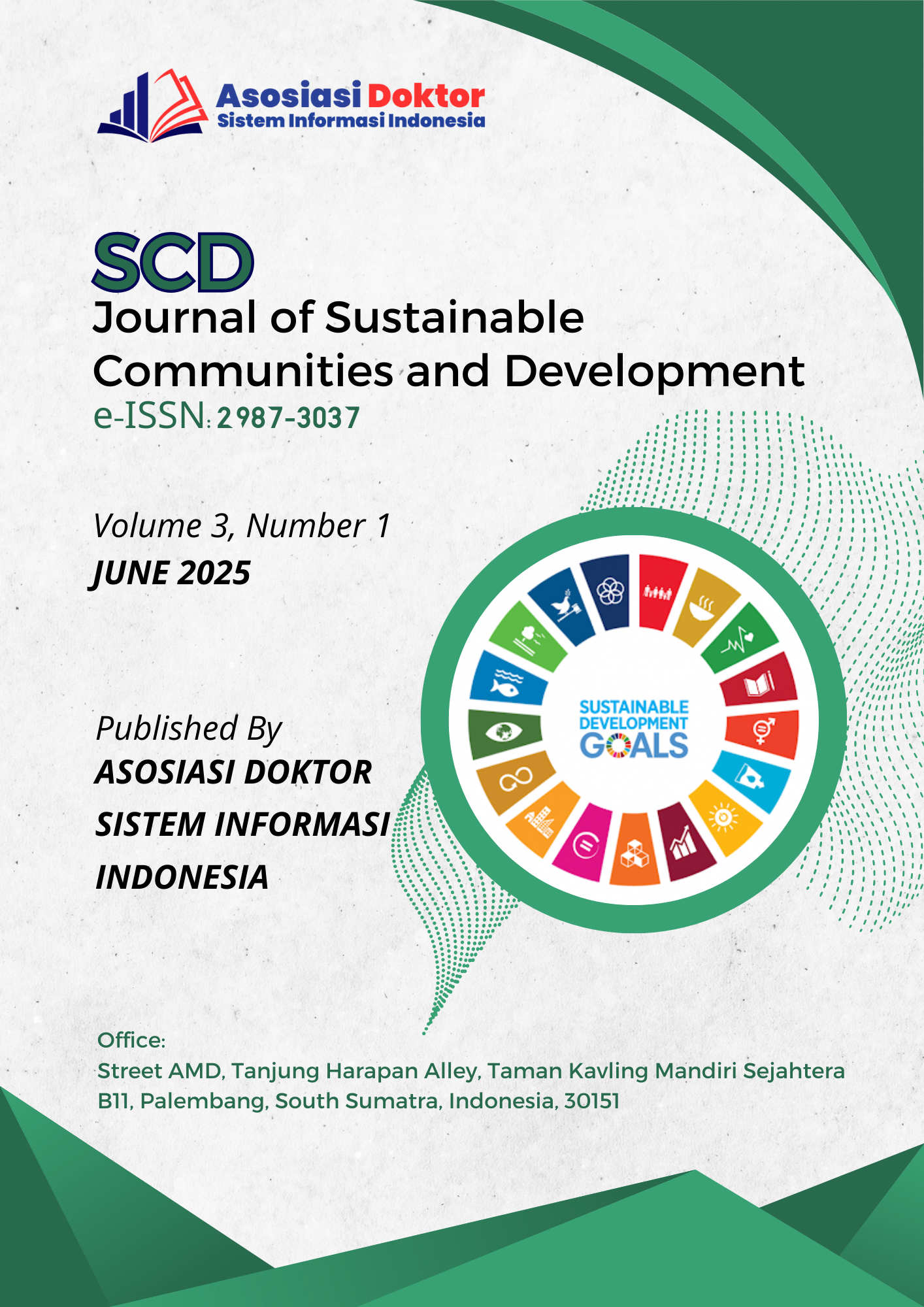Penguatan Peran Sanitasi Lingkungan dalam Pencegahan Stunting Melalui Edukasi Kesehatan di Posyandu Cipajaran, Puskesmas Sangkali
DOI:
https://doi.org/10.63158/SCD.v3i1.18Keywords:
Environmental Sanitation, Public Health Education, Stunting Prevention, Community Awareness, TasikmalayaAbstract
This community service project aimed to enhance public knowledge about environmental sanitation as a preventive measure against stunting at Posyandu Cipajaran, located within the Sangkali Health Center area in Tasikmalaya City. The activity was carried out in three stages: (1) Preparation, involving coordination with local health officials to determine logistics and the development of educational materials and assessment tools; (2) Implementation, which consisted of health education sessions delivered through lectures supported by PowerPoint presentations, followed by interactive discussions; and (3) Evaluation, where participants completed both pre-test and post-test questionnaires to measure knowledge improvement. The results demonstrated a significant increase in public understanding, with the average knowledge score rising from 38.91 to 63.29. Additionally, the proportion of participants with a good level of knowledge increased markedly, from 3.2% before the intervention to 22.6% afterward. These findings indicate that targeted health education can effectively improve community awareness and support stunting prevention efforts.
References
M. Gebreayohanes and A. Dessie, “Prevalence of stunting and its associated factors among children 6–59 months of age in pastoralist community, Northeast Ethiopia: A community-based cross-sectional study,” PLoS One, vol. 17, no. 2, pp. 1–15, 2022, doi: 10.1371/journal.pone.0256722.
R. Hasanah, F. Aryani, and B. Effendi, “Pemberdayaan masyarakat dalam pencegahan stunting pada anak balita,” J. Masyarakat Madani Indones., vol. 2, no. 1, pp. 1–6, 2023.
UNICEF and World Health Organization, Levels and trends in child malnutrition: key findings of the 2019 edition of the Joint Child Malnutrition Estimates. Geneva: World Health Organization, 2020.
L. K. B. Prasetya, “Tantangan Menuju Prevalensi Stunting 14%: Mengapa Penurunan Prevalensi Stunting Dalam 2 Tahun Terakhir (Tahun 2021 Dan 2022) Sangat Kecil Di Indonesia?,” J. Keluarga Berencana, pp. 1–7, 2024.
I. D. N. Supariasa and H. Purwaningsih, “Faktor-faktor yang mempengaruhi kejadian stunting pada balita di Kabupaten Malang,” Karta Rahardja, J. Pembangunan dan Inovasi, vol. 1, no. 2, pp. 55–64, 2019.
R. Astuti, N. Martini, S. Gondodiputro, M. Wijaya, and A. Mandiri, “Risiko faktor ibu terhadap kejadian stunting,” JKM (J. Kebidanan Malahayati), vol. 7, no. 4, pp. 842–850, 2021.
E. Kusumawati, S. Rahardjo, and H. P. Sari, “Model pengendalian faktor risiko stunting pada anak usia di bawah tiga tahun,” J. Kesehatan Masyarakat, vol. 9, no. 3, pp. 249–256, 2015.
A. Soliman et al., “Early and long-term consequences of nutritional stunting: From childhood to adulthood,” Acta Biomed., vol. 92, no. 1, Mar. 2021, doi: 10.23750/abm.v92i1.11346.
M. Rosyidah, Y. Lanti, R. Dewi, and I. Qadrijati, “Effects of stunting on child development: A meta-analysis,” J. Matern. Child Health, vol. 6, no. 1, pp. 25–34, 2021, doi: 10.26911/thejmch.2021.06.01.03.
A. Ademas, M. Adane, A. Keleb, G. Berihun, and G. Tesfaw, “Water, sanitation, and hygiene as a priority intervention for stunting in under-five children in northwest Ethiopia: A community-based cross-sectional study,” Ital. J. Pediatr., vol. 47, no. 1, pp. 1–11, 2021, doi: 10.1186/s13052-021-01128-y.
N. N. Annashr et al., “Penguatan 5 pilar sanitasi total berbasis masyarakat dalam upaya pencegahan stunting,” JMM (J. Masyarakat Mandiri), vol. 7, no. 6, pp. 5901–5911, Dec. 2023, doi: 10.31764/jmm.v7i6.19342.
V. Pramaningsih et al., “Edukasi pencegahan stunting melalui sanitasi pengelolaan sampah dan higiene di SD Muhammadiyah 4 Samarinda,” Selaparang: J. Pengabdian Masyarakat Berkemajuan, vol. 8, no. 2, pp. 1439–1444, 2024.
S. Hasanah, S. Handayani, and I. R. Wilti, “Hubungan sanitasi lingkungan dengan kejadian stunting pada balita di Indonesia (studi literatur),” J. Keselamatan Kesehatan Kerja dan Lingkungan, vol. 2, no. 2, pp. 83–94, 2021, doi: 10.25077/jk3l.2.2.83-94.2021.
H. Torlesse, A. A. Cronin, S. K. Sebayang, and R. Nandy, “Determinants of stunting in Indonesian children: Evidence from a cross-sectional survey indicate a prominent role for the water, sanitation and hygiene sector in stunting reduction,” BMC Public Health, vol. 16, no. 1, pp. 1–11, 2016, doi: 10.1186/s12889-016-3339-8.
C. S. Kwami, S. Godfrey, H. Gavilan, M. Lakhanpaul, and P. Parikh, “Water, sanitation, and hygiene: Linkages with stunting in rural Ethiopia,” Int. J. Environ. Res. Public Health, vol. 16, no. 20, 2019, doi: 10.3390/ijerph16203793.
D. Marfuah and I. Kurniawati, Buku Ajar Pola Pemberian Makanan Pendamping Air Susu Ibu yang Tepat. Surakarta: CV AE Media Grafika dan FIK ITS PKU Muhammadiyah Surakarta, 2022.
D. Setiawan, F. Ardianto, S. G. Puspita, C. Khulia, Z. Ghoniyyah, and T. M. Fahrudin, “Edukasi sanitasi lingkungan sebagai upaya pencegahan stunting di SMP Penanggungan Kesemen, Ngoro, Mojokerto,” J. Pengabdian Kepada Masyarakat, vol. 1, no. 2, pp. 18–29, 2022.
F. Minarti, F. A. Nasution, R. Amalia, and D. Ciselia, “Sosialisasi sanitasi lingkungan upaya pencegahan stunting pada ibu rumah tangga di wilayah kerja Puskesmas Sukajadi Kelurahan Sukajadi Kabupaten Banyuasin Tahun 2023,” Kemas J.: J. Pengabdian Masyarakat, vol. 1, no. 2, pp. 62–69, Dec. 2023, doi: 10.31851/kemas.v1i2.13342.
Published
Issue
Section
License
Copyright (c) 2025 Nissa Noor Annashr, Andy Muharry, Neni, Nisa Khoerunisa (Author)

This work is licensed under a Creative Commons Attribution 4.0 International License.
















